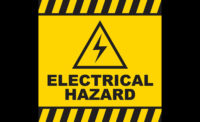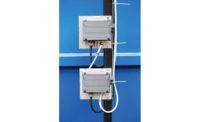NFPA 70E® provides a comprehensive & effective program
Spark safety improvements

When it comes to workplace safety and operational performance, good enough is not an option. What is the difference between comprehensive safety and just checking a compliance box?
The total cost of safety cannot be underestimated. A life is priceless. Direct costs such as worker’s compensation, medical and legal expenses, and indirect safety costs such as training, accident investigation, implementation of corrective measures, lost productivity, equipment and property repairs add up quickly. Workplaces with safety problems have lower employee morale and productivity.
Technology-driven changes are increasing workplace complexity. Equipment and safety devices are constantly improving. Industry 4.0 is focusing on the transition to smart factories, where machines, devices, sensors, and people will interact via the Internet of Things (IoT).
How to tackle these challenges in the context of workplace safety? There are five critical areas that must be addressed for a comprehensive and effective safety approach. In this article, we will look at them in the context of NFPA 70E®, where the focus in on the safety of employees who are exposed to electrical hazards arising from the use of electricity. But the same approach can be used in the context of other hazards, such as combustible dust and others.
Electrical safety program
First and foremost, the employer needs to establish a company-wide, all-encompassing safety program. NFPA 70E, Section 110.1 requires an Electrical Safety Program, a written document that directs activity appropriate for the risk associated with electrical hazards. Its scope includes safety principles, policies, procedures, controls, awareness of hazards, risk assessments, job safety plans/job briefings, audits, incidents investigation, and training, among others. The key objective of the Electrical Safety Program is to provide overall guidance.
Hazard assessment
Section 130.2 requires that electrical equipment operating at voltages greater than 50 volts be put into an electrically safe working condition (disconnected from energized parts, locked/tagged, tested for absence of voltage, and grounded if necessary) before a worker performs work on the equipment. Organizations need to establish an effective Lockout/Tagout program to address this requirement.
When an electrically safe working condition cannot be established, electrically safe work practices must be used before any worker is exposed to hazards. Section 130.5 requires an arc flash assessment to be performed to determine the risks, the safe work practices required, the arc flash boundary, the incident energy exposure level at the working distance, and additional protective measures required, including the use of PPE. When work is performed under these conditions, an energized electrical work permit is required if the work is performed within the restricted approach boundary.
There can be confusion regarding the requirements and best approach to accomplish an effective arc flash assessment. There are a large number of standards and the various methods that can be used to calculate and quantify arc flash hazards. It is important to realize that not all arc flash assessments are equal and can vary in scope from high-level view, ensuring all points are thoroughly assessed.
There are also misconceptions, including one that equipment supplied from a panel rated at 1.2 cal/cm2 (hazard category 0) will also be rated the same. There are scenarios where this may not be the case. The lower the fault current, the longer it will take a fuse or circuit breaker to open. If there are long cable runs, transformers, or other overcurrent protective devices, the incident energy and hazard risks can increase at panels and equipment downstream.
As stated in NFPA 70E 130.5 (H) and NEC 110.16, switchboards, panelboards, industrial control panels, meter socket enclosures, motor control centers, and disconnect switches or circuit breakers that may be examined, adjusted, or maintained while energized must be labeled to warn of potential electrical shock and arc flash hazards.
Hazard prevention
Preventive measures lower the probability of a scenario from happening. Proactivity towards prevention lowers safety risks. Examples include preventive maintenance (an example, is infrared thermography) to reduce the risk of equipment failure, job safety planning / job briefings, and safety audits, among others.
Hazard mitigation
After risks are identified, risk mitigation needs to be effectively implemented according to the hierarchy of control methods:
Elimination, substitution, and engineering controls are the most effective methods. They are usually applied at the source and are less likely to be affected by human error compared to awareness, administrative controls, and PPE.
The potential for human error and its negative consequences on people, processes, the work environment, and equipment must be considered during the implementation of mitigation measures.
Electrical safety training
Training workers (employees and contractors) that are exposed to hazards is critical to workplace safety, particularly when the hazard risk is not eliminated or reduced to a safe level. Workers need to be able to identify and understand the specific hazards associated with their respective job assignments. In the context of NFPA 70E, the training scope includes electrical safety, lockout /tagout, and emergency response in a classroom setting, on-the-job, or a combination of the two. A worker will be considered a qualified person if he/she is qualified to perform the job safely: is trained and knowledgeable about the equipment and work method, is able to identify the associated electrical hazards, and is familiar with the proper use of the precautionary procedures, techniques, tools, and PPE required to avoid them. Only qualified persons should be permitted to work exposed to electrical hazards that have not been put into an electrically safe working condition.
Workplace safety is a key enabler of business continuity, operational performance, and productivity. Addressing these five key areas effectively will help you achieve a best-in-class safe, healthy, and productive workplace.
Looking for a reprint of this article?
From high-res PDFs to custom plaques, order your copy today!





